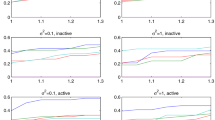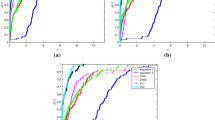Summary
The conjugate gradient method is developed for computing stationary probability vectors of a large sparse stochastic matrixP, which often arises in the analysis of queueing system. When unit vectors are chosen as the initial vectors, the iterative method generates all the extremal probability vectors of the convex set formed by all the stationary probability vectors ofP, which are expressed in terms of the Moore-Penrose inverse of the matrix (P−I). A numerical method is given also for classifying the states of the Markov chain defined byP. One particular advantage of this method is to handle a very large scale problem without resorting to any special form ofP.
Similar content being viewed by others
References
Decell, H. P. and Odell, P. L. (1967). On fixed point probability vector of regular or ergodic transition matrices,J. Amer. Statist. Ass.,62, 600–602.
Feller, W. (1957).An introduction to probability theory and its applications, Vol. 1 (2nd ed.), Wiley, New York.
Hestenes, M. R. and Stiefel, E. (1952). Method of conjugate gradients for solving linear systems,J. Res. Nat. Bur. Standards,49, 409–436.
Kammerer, W. J. and Nashed, M. Z. (1972). On the convergence of the conjugate gradient method for singular operator equations,SIAM J. Numer. Anal.,9, 165–181.
Odell, P. L. and Decell, H. P. (1967). On computing the fixed-point probability vector of ergodic transition matrices,J. ACM,14, 765–768.
Pearl, M. (1973).Matrix theory and finite mathematics, McGraw-Hill, New York.
Penrose, R. (1955). A generalized inverse for matrices,Proc. Cambridge Phil. Soc.,51, 406–413.
Rao, C. R. and Mitra, S. K. (1971).Generalized inverse of a matrices and its applications, Wiley, New York.
Reid, J. K. (1971). On the method of conjugate gradients for the solution of large sparse systems of linear equations,Proc. Conference on “Large sparse set of linear equations”, Academic Press, New York.
Romanovsky, V. (1936). Recherches sur les chaines de Markoff,Acta Math., Stockh.,66, 147.
Tanabe, K. (1975). The conjugate gradient method for computing all the extremal stationary probability vectors of a stochastic matrix,The Institute of Statistical Mathematics Research Memorundum,72.
Tanabe, K. (1976). Generalized inverses of matrices (3) (in Japanese),Communication of the Operations Research Society of Japan,21, 324–326.
Additional information
The Institute of Statistical Mathematics
About this article
Cite this article
Tanabe, K. The conjugate gradient method for computing all the extremal stationary probability vectors of a stochastic matrix. Ann Inst Stat Math 37, 173–187 (1985). https://doi.org/10.1007/BF02481090
Received:
Revised:
Published:
Issue Date:
DOI: https://doi.org/10.1007/BF02481090




